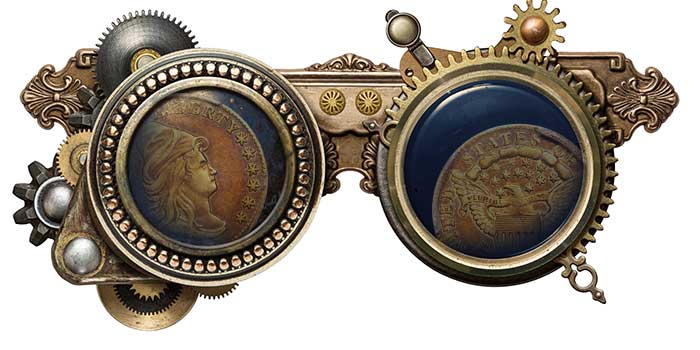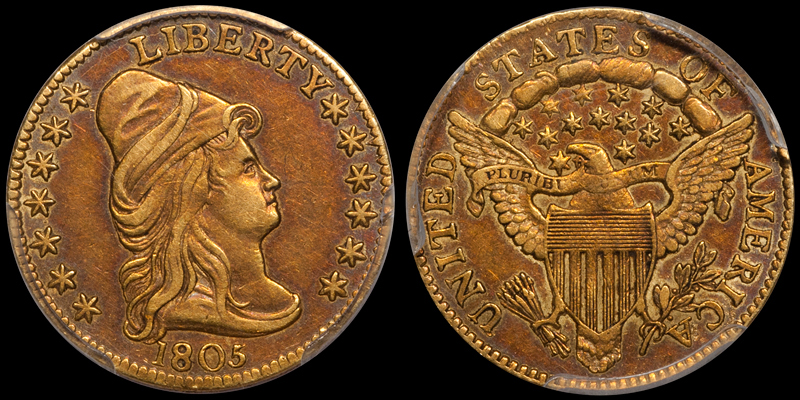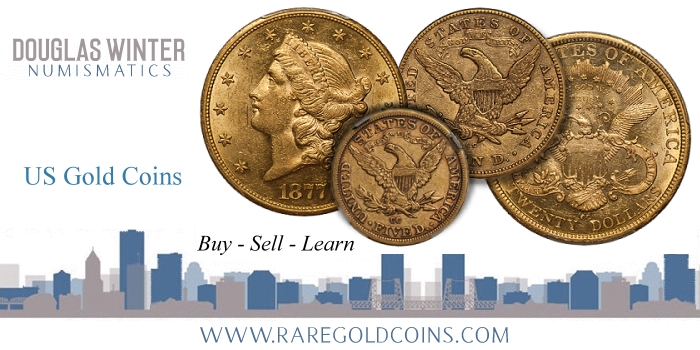
Gold coins with Doug Winter – RareGoldCoins.com ……
CoinWeek Content Partner ……
This blog is inspired by reader D.N. who recently sent me a nice unsolicited email including the following statement: “…you may be the only dealer of any US series ( including gold ) that strictly employs an advanced copper collector approach to quality: originality, luster, surfaces, color, eye appeal, etc. with little compromise.”
While I didn’t really set out to approach my specialty (US gold coinage, 1795-1933) with a copper collector’s mindset, I understand this comment and am appreciative of it.
I have a very strict set of standards when it comes to purchasing coins for my inventory and I’d like to share some of them with you. These will deal with the four categories mentioned above by D.N. We will also briefly touch on strike, which is the least important factor for copper–and gold–collectors to consider.
Originality
To me, “originality” is the single most important factor in determining whether or not I will buy a coin. The term “original” is almost constantly misused by dealers and collectors alike. When the term is used, there is, obviously, no way of knowing for certain whether or not a coin has never been cleaned, dipped, lightened, processed or otherwise altered in an attempt to make it appear “better” or “different”. It should be stressed that originality is essentially an opinion, not a fact.
I’d estimate that at least 90% of all circulated US gold coins have been cleaned at one time. Some of these were lightly cleaned or wiped with a cloth 100+ years ago, and they have acquired secondary toning that is nearly impossible to tell apart from totally original first-generation color.
I have written about hoards of US gold coins that have been repatriated from overseas sources and how many of the coins from these sources have a very original appearance. Since these haven’t been available to dealers and collectors for many generations, their color is likely totally original. We can state with certainty that banks in Switzerland were not busy dipping their No Motto eagles in an attempt to make their AU50 coins appear to look AU58.
As a rule of thumb, I apply very rigorous standards toward common date issues. For example, I will only buy an 1848 half eagle (a very common date in grades through MS62 to MS63) if it is extremely original in my opinion. But on a coin like an 1865 half eagle, which is rare to very rare in any grade, I am much less strict and I will knowingly buy an example even if it has been lightly cleaned.
Luster
For coins grading About Uncirculated and higher, luster is a very important factor in evaluating gold coins; far more so than it is for copper.
There are numerous types of luster seen on gold coins and it is very important for collectors to recognize and distinguish between them. Luster can be a product of the design of a coin, the mint at which it was struck, and how new the dies used to strike the coin were.
The various types of luster seen include frosty, satiny, semi-prooflike, and prooflike, with hybrids of these types seen.
Collectors will quickly learn, for example, that 1888 Three Dollar gold pieces typically show thick, frosty luster, while 1861 Three Dollar gold pieces have a more satiny texture. Low-mintage dates (such as 1881 or 1885) tend to come prooflike.
Since the advent of third-party grading, numerous circulated gold coins have been treated in an attempt to simulate mint luster. This often fools novice collectors but more experienced buyers are turned-off by these bright, shiny coins.
Surface
The term “surface” when it applies to gold coins really means the preservation of the obverse and the reverse, particularly in regards to marks that result from circulation. Gold is the softest coinage metal and when a gold coin is transported to banks in bags or when it enters circulation, it is liable to acquire deep, detracting marks. This is even more likely with large coins like double eagles.
Marks are most detracting when they are in prime focal points. A reeding mark (from contact with the edge of another coin) placed right on the face of Liberty is a deal-killer for me 90% of the time, while the exact same mark hidden away on the lower reverse wouldn’t bother me in the least.
Surface issues can also be mint-made. Early gold coins often show adjustment marks, which I don’t find detracting unless they are either excessively deep or they are placed right on Liberty’s cheek. Other issues might include black grease stains, reddish copper spots, small laminations, etc.
Finally, surface issues are often attempts to hide problems. I am continually amazed at the number of early gold or Territorial issues that are straight-graded by PCGS or NGC with tooled, scratched, or burnished areas on the surface.
It’s been written that the edge is the “third side” of the coin and most collectors (and dealers) are guilty of ignoring this when they examine a coin. Even if a coin is slabbed, the edge should be carefully examined to check for rim nicks or tooling.
Color
The copper collector is likely far more concerned with color than the gold coin collector. This is due to the fact that original red coloration on copper makes a coin worth potentially many multiples more than a brown coin. This is not the case with gold coins, although pieces with unusual but unquestionably natural color are beginning to command premiums among collectors.
In all the books I have written on gold coins, I discuss the “right” color for specific issues in great detail. I do this so a novice collector can learn to appreciate an original appearance. As an example, I think it’s important for the collector to know what the proper color is for an 1852-C quarter eagle.
Colors can range greatly. If the gold used to strike a coin is from the Comstock Lode, it is bound to have a different hue than gold from Appalachia. All US gold coins contain 90% gold, but the alloys used contain different percentages of copper or silver depending on the source of the ore.

A toned 1805 $2.50 PCGS AU50, from the Douglas Winter Numismatics Archives
On rare occasions, US gold coins can show spectacular deep color. This may be the result of storage in a leather pouch or in an environment volatile enough to impart strong overlying colors. In the past, coins of this nature were either dipped or shunned but they have now become popular. They still do not command a huge premium (as would a rainbow-toned silver coin or a multi-hued copper coin) but I expect premiums for coins of this sort to increase dramatically in the coming years.
Eye Appeal
“Eye appeal” is basically the sum of all the individual components we’ve touched on above. A coin has good overall eye appeal because it is original, minimally abraded, and has attractive coloration.
The grading services have made eye appeal the primary component of establishing grade. You can have a coin with far more marks than you would expect for the grade (say AU55) still grade AU58, MS61, or even MS62 because it has excellent eye appeal. Collectors who grade strictly on technical standards will always have trouble buying coins as this set of standards is outdated; right or wrong.
Strike
Before we end this blog, a quick mention should be made regarding strike. I regard strike as a very minor factor in the decision to buy—or not to buy—a gold coin.
There are certain issues where a percentage of the known coins come poorly struck but sharply struck pieces are available; the 1844-D quarter eagle comes to mind. In the case of this issue, I could see passing on a weakly struck example that was otherwise nice while waiting for a sharply struck coin. I can also see passing on a coin with a weak mintmark (the 1850-C half eagle as an example) and waiting for an example with a sharp mintmark.
In the case of an issue that is notorious for weak strikes (the 1856-D quarter eagle is a perfect example), the collector should never pass on an otherwise choice coin hoping for a better-struck piece. It likely doesn’t exist.
Thanks—again—to reader D. N. and if you’d like to see a blog written based on one of your questions or comments, then please, feel free to email me at [email protected].
* * *
About Doug Winter
 Doug has spent much of his life in the field of numismatics; beginning collecting coins at the age of seven, and by the time he was 10 years old, buying and selling coins at conventions in the New York City area.
Doug has spent much of his life in the field of numismatics; beginning collecting coins at the age of seven, and by the time he was 10 years old, buying and selling coins at conventions in the New York City area.
In 1989, he founded Douglas Winter Numismatics, and his firm specializes in buying and selling choice and rare US Gold coins, especially US gold coins and all branch mint material.
Recognized as one of the leading specialized numismatic firms, Doug is an award-winning author of over a dozen numismatic books and the recognized expert on US Gold. His knowledge and an exceptional eye for properly graded and original coins has made him one of the most respected figures in the numismatic community and a sought after dealer by collectors and investors looking for professional personalized service, a select inventory of impeccable quality and fair and honest pricing. Doug is also a major buyer of all US coins and is always looking to purchase collections both large and small. He can be reached at (214) 675-9897.
Doug has been a contributor to the Guidebook of United States Coins (also known as the “Redbook”) since 1983, Walter Breen’s Encyclopedia of United States and Colonial Coins, Q. David Bowers’ Encyclopedia of United States Silver Dollars and Andrew Pollock’s United States Pattern and Related Issues
In addition, he has authored 13 books on US Gold coins including:
- Gold Coins of the New Orleans Mint: 1839-1909
- Gold Coins of the Carson City Mint: 1870 – 1893
- Gold Coins of the Charlotte Mint: 1838-1861
- Gold Coins of the Dahlonega Mint 1838-1861
- The United States $3 Gold Pieces 1854-1889
- Carson City Gold Coinage 1870-1893: A Rarity and Condition Census Update
- An Insider’s Guide to Collecting Type One Double Eagles
- The Connoisseur’s Guide to United States Gold Coins
- A Collector’s Guide To Indian Head Quarter Eagles
- The Acadiana Collection of New Orleans Coinage
- Type Three Double Eagles, 1877-1907: A Numismatic History and Analysis
- Gold Coins of the Dahlonega Mint, 1838-1861: A Numismatic History and Analysis
- Type Two Double Eagles, 1866-1876: A Numismatic History and Analysis
Finally, Doug is a member of virtually every major numismatic organization, professional trade group and major coin association in the US.






I cannot agree more with the explanation on Gradng, considering Strike, Color. eye appeal and
lustre are the major factors is ascertaining a Grade of a Gold Coin. I believe, as many old time
dealers and specialists have told me, that the SIMPLISTIC NUMERICAL GRADING, omits what
can and does express what the buyer should see. We at Stack’s and later Stack’s Bowers. had
in the earlier days of describing a coin, adhered to the ADJECTIVAL GRADE, for it exprressed,
with the average coin can reveal, more exact description of the actual GRADE as seen by a
qualified Grader. NUMERICAL GRADE is to me a Short Cut in expressing a grade, and therefore
can be misleading when one who is not fully trained to understand the NUMBER , looks at
the highest number, and feels it is a correct grade. The variance between a 61 and 63, or
say a 55 and 58, or between a 67,68 or 69, is so infinitesimal that higher sums are paid for
the higher number, because of the ARBITRARY NUMERICAL GRADE assigned to it by a Service
or Professional. Since I have lived through the development from the SHELDON NUMERICAL
GRADE SYSTEM FOR LARGE COPPER CENTS , till today with the use of the NUMERICAL GRADE,
(which is primarily the SYSTEM used by the Various GRADING SERVICES and making the
buyer feel that they know best ! (For the record, I know of many , many cases, where
the simple NUMERICAL GRADE was raised, (UPGRADED) when resubmitted from one SERVICE
TO ANOTHER, ( OR SENT BACK TO THE ORIGINAL SERVICE) that the exact qualities that make
one opinion SUPERIOR to ANOTHER, starts to become a VERY MUTE POINT.
YES , WE USE NUMERICAL GRADING, BUT , WHEN DESCRIBING A COIN we also express our
opinion as to the use in conjunction with the number, a extended ADJECTIVAL EXPRESSION,
so that the buyer can evision what he is getting and can visualize the grade.
I believe all who GRADE A COIN, should adhere to the following : ‘”GRADING IS IN THE EYE
OF THE OBSERVER,” and when used with a fuller ADJECTIVAL grade, provides more of
on indication, just what one is acquiring. I always think of the famous saying I heard for
decades, ”OLD SYSTEM DO NOT DIE, THEY JUST FADE AWAY ” , I SURELY FEEL THAT
ADJECTIVAL GRADING HAS A LONG WAY TO GO BEFORE IT WILL FADE AWAY !!!!!!